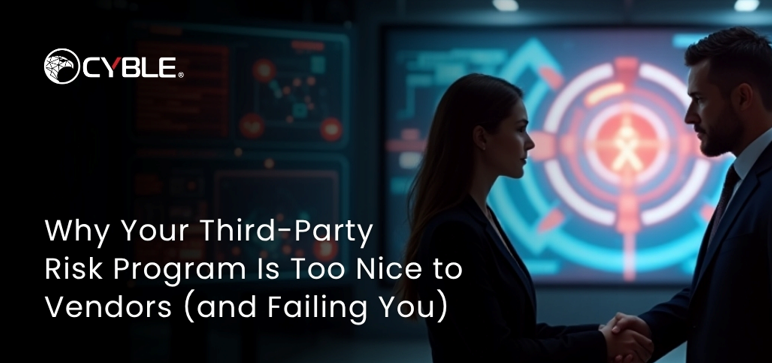Why Your Third-Party Risk Program Is Too Nice to Vendors (and Failing You)

Today, the ability of every business to conduct its operations smoothly depends on a third-party vendor, partner, and supplier ecosystem. Whether it is cloud service, logistics, or many other operations, you are reliant on a complex interplay of third parties. The problem is your Third-Party Risk Program may be too accommodating, too trusting, and too nice to vendors.
Being “nice” comes with a cost – it allows security blind spots to be built, risks to go unmanaged, and poor contracts to go unchallenged. In summary, a third-party risk program that does not set firm limits ultimately creates exposure for your organization to real harm.
When “Niceness” Becomes a Liability
Understanding why companies often go easy on vendors is easy to do. Sometimes companies simply want a good relationship. Companies often do not want to create a bottleneck or slow things down by making hard demands about security or lots of audits. This is where vendor risk program weaknesses start to leak into your company.
Imagine you hired a new software vendor to manage sensitive customer data. The vendor tells you their security is “top-shelf,” and you accept their word. Your relationship goes back a few years, and then you do not want to make them go through the full risk analysis process again.
A few months later, the vendor suffers a data breach, and your customers’ sensitive data is eventually leaked on the Internet. This is how vendor complacency risk turns into a substantial event. Being courteous and trusting in business is not bad. Being unaware of risk is.
The Hidden Problem: Weak Third-Party Controls
One of the main reasons why many Third-Party Risk Programs do not perform well is the weak third-party control framework. Companies, in general, do not have sufficient visibility of the activities going on in the networks of their vendors. Typically, they depend on outdated assessments or self-attestation forms that the vendors fill out once a year, and then, the forms are filed away until the next renewal — highlighting the growing need for effective third party risk management solutions.
Cyber threats do not wait for annual reviews. Attackers take advantage of these unnoticeable gaps, aiming their attacks at the weakest point in the supply chain. This has been observed in a number of industries where the breach of an external service provider has led to the compromise of hundreds of businesses downstream.
A fully developed Third-Party Risk Program should always go beyond just paperwork. It should incorporate mechanisms for continuous monitoring, real-time alerts, and periodic testing of controls.
Vendor Oversight: Still Too Lenient for Today’s Threats
Countless organizations mistakenly consider lax vendor supervision as their way of managing risks. They dread the possible negative impacts such as losing the partners or putting the projects on hold. The outcome is a culture in which vendors are seldom questioned, leading to unclear responsibility.
Experts refer to this leniency as the third-party risk maturity gap— a divergence between how companies view their vendor management capability and how strong it actually is. A vendor may present itself as compliant but without proper validation, those controls could be ineffective.
For instance, you have a vendor that gives you cloud hosting for critical business operations. If you never check their response during an outage or a cyber incident, you may end up discovering their weaknesses when it’s too late. This is a vendor relationship risk that you cannot do without.
Factors That Contribute to The Failure of Third-Party Risk Programs
There’s no singular reason contributing to the poor efficacy or outright failure of third-party risk programs. However, patterns are recognizable:
- Blind Trust: Just trusting the vendor’s statements without validating their claims.
- Reactive: Addressing a risk after a security incident occurs.
- No Prioritization: Treating all vendors equally, regardless of their inherent risk.
- Lack of Communication: Security personnel, procurement, and business units not communicating the risk of vendors.
This grouping leads to the vendor risk management program rand only in theory, not through actions related to the key risk considerations.
From Nice to Necessary: Creating Accountability
It is important that these issues move from “nice to have” to “necessary to have”. This means that you are going to set expectations early, enforce those expectations consistently, and then evaluate compliance using evidence.
For example, if you have a vendor that is handling your payment information, you would want either the evidence of your data being encrypted and limited access or for that vendor to be willing to allow you some form of testing to demonstrate compliance. If they are unwilling to provide evidence, it may be time to rethink the relationship. True partnership means transparency—not just a comfortable relationship.
Both the organization and the vendor need to have contingency plans in place for deficiencies in the program they are managing on your behalf, because even the most trusted vendors may fail. Responsibility cannot be assumed, and having alternate vendors, data recovery plans, and contractual clauses for cyber incidents can mitigate failure and ensure the business is not brought to a complete stop over a third-party incident.
A Growing Market, and Responsibilities
The global third-party risk management market is growing. In 2023, it was valued at USD 7.42 billion and is projected to reach USD 20.59 billion by 2030. Given that businesses are finally waking up to the realization that there are various risks present in their extended ecosystem which are difficult to identify and manage, this is both an expected growth and the impetus for businesses to have a reasonable expectation of risk.
As supply chains become more complicated, and the digital world becomes more static, every vendor you have adds at least one more doorway to your organization. If you are not paying attention to securing each of these doorways, every vendor can simply serve as another entry point for the bad actors.
How Cyble Strengthens Third-Party Risk Programs
Cyble’s Third-Party Risk Management is all about the organization focusing on the vendor ecosystem getting visibility, accountability, and resilience built into it. By means of advanced AI threat intelligence and continuous monitoring, Cyble is able to assist businesses in discovering the weak points in their vendor networks and in consequently taking swift actions to mitigate the risks that are coming up.
Through the use of proactive insights and real-time assessments, Cyble’s solution is an enabler of maturing and adapting Third-Party Risk Program that provides an equal share of partnership and protection. Cyble does not eliminate the human judgment but rather superimposes it with data-driven intelligence.
Conclusion
In the field of AI in Cybersecurity, being kind without being cautious can lead to expensive mistakes. Vendors are very important, but your task is to protect your business first. If your Third-Party Risk Program is very polite to vendors, it is most likely too weak to defend you. Accountability is not synonymous with hostility — it is a sign of maturity. The most robust companies are the ones that consider vendor risk to be a joint responsibility instead of a one-sided trust-building exercise. The reason for this is that at the end of the day, the goal is not to be nice.




